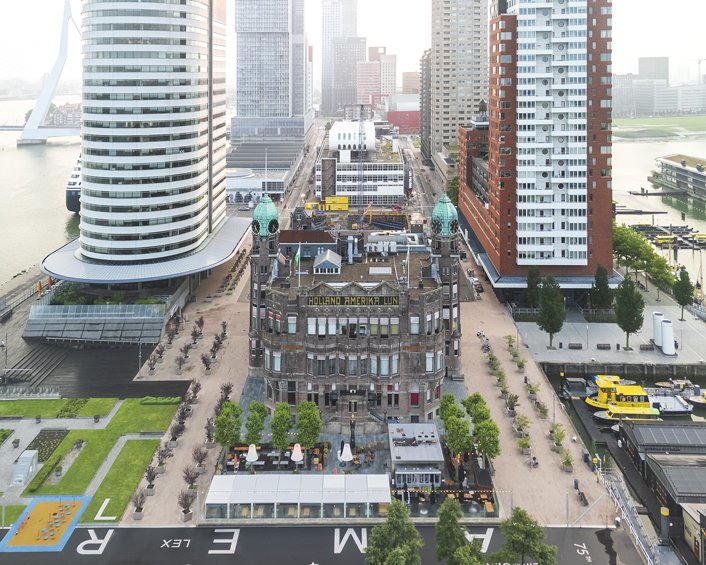Photographing The Fenix Museum Rotterdam
Fenix Museum in Rotterdam at sunset
Where Migration Meets Architectural Marvel
Have you ever stood in a space where history, architecture, and human stories converge so powerfully that you can almost feel the weight of three million journeys? That's precisely what happens when you step into Rotterdam's newest cultural landmark, the Fenix Museum, the first stop of my 2025 European architectural photography road trip.
Opening its doors in May 2025, this extraordinary museum explores the profound themes of migration through art, and it couldn't be housed in a more fitting location. Nestled in Rotterdam's former red-light district and Europe's oldest Chinatown, the museum occupies a magnificently restored warehouse that once served as the departure point for countless dreams and desperate escapes.
A Building with Stories to Tell
The structure itself is a marvel of architectural transformation. What was once the San Francisco Warehouse, completed in 1923, has been reimagined by Ma Yansong, the visionary head of MAD Architects—quite literally architectural royalty. The building originally served as a crucial storage and trans-shipment hub for the Holland America Line company, whose former headquarters now stands across the water as the elegant Hotel New York.
But it's what crowns this historic building that truly takes your breath away. Rising above the 16,000 square metres of museum space is The Tornado—a gleaming chrome double helix stairway that spirals skyward like a frozen whirlwind. Ma Yansong has described migration as being fundamentally about movement, and The Tornado is his interpretation of that movement captured in a static monument. It's a powerful metaphor made manifest in steel and shine.
The Devil's in the Details
The craftsmanship of The Tornado is nothing short of extraordinary. Each of the 297 steel panels required 100 hours of polishing to achieve that mirror-like finish that catches Rotterdam's ever-changing light. Standing beneath it, you can't help but appreciate both the ambition of the concept and the meticulous attention to detail that brought it to life.
The walkable structure offers visitors something truly special—a panoramic view of the city that extends across the River Maas to the Hotel New York. From this vantage point, you can see the very waters that carried over three million emigrants to new lives in America and Canada during the late 19th century. Among those who departed from these very quays were figures as diverse as Albert Einstein, Willem de Kooning, Johnny Weissmuller, and even the infamous Lee Harvey Oswald.
Light, Space, and Artistic Expression
Inside, the museum's two exhibition floors are flooded with natural light streaming through the immense windows—a photographer's dream and a perfect complement to the subject matter on display. Retaining the concrete internal structure adds an unexpected brutalist edge that feels remarkably contemporary. There's something quite chic about this raw architectural honesty, particularly given brutalism's current moment in the design spotlight.
The space houses an impressive variety of artworks, from classic pieces to interactive installations that invite visitors to engage with the migration narrative in deeply personal ways. But perhaps the crown jewel of the collection is the permanent home now given to Willem de Kooning's 'Man in Wainscott'—a fitting tribute to the Rotterdam native who became a pivotal figure in Abstract Expressionism after his own migration to America.
More Than Just a Museum
What strikes me most about the Fenix Museum is how it manages to be simultaneously a celebration of human resilience and a sobering reminder of displacement. The building itself embodies this duality—transformed from a utilitarian warehouse into a cultural beacon, yet retaining enough of its industrial character to remember its working past.
The architectural intervention by Ma Yansong doesn't overwhelm the existing structure but rather creates a dialogue between old and new, between the static and the dynamic. The Tornado doesn't just provide views; it offers perspective—both literal and metaphorical—on the journeys that have shaped our world.
A New Chapter for Rotterdam
Rotterdam has always been a city that understands transformation. Rebuilt after the devastation of World War II, it has consistently embraced bold architectural visions. The Fenix Museum represents another chapter in this story—one that acknowledges the city's role in the global movement of people whilst celebrating the cultural richness that migration brings.
As I stood in those light-filled galleries, surrounded by stories of departure and arrival, I couldn't help but reflect on how architecture can serve as both vessel and voice for human experience. The Fenix Museum isn't just housing art about migration; it's become part of the migration story itself—a warehouse reborn, a community transformed, and a city continuing to evolve.
The Fenix Museum proves that the most powerful cultural spaces are those that don't just display history—they continue to write it. And with The Tornado spiralling skyward, catching the light and reflecting the city below, it's clear that Rotterdam's newest cultural landmark is ready to welcome the next chapter of its remarkable story.
The Fenix Museum is located at Paul Nijghkade 5, 3072 AT Rotterdam. The museum is open Tuesday to Sunday 10am to 5pm (late opening until 9pm Thursday), with The Tornado accessible during museum hours for panoramic city views.
















